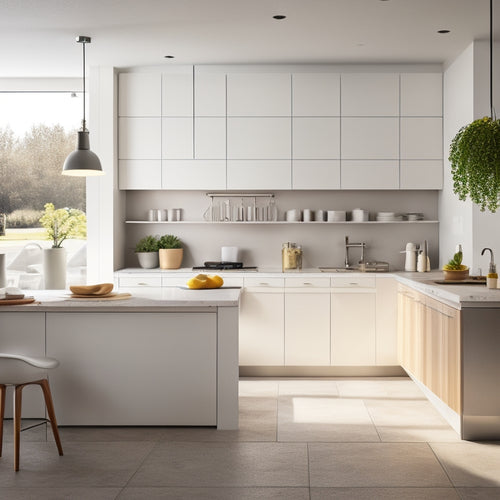
Optimizing Commercial Kitchens for Efficiency and Success
Share
Optimizing a commercial kitchen for efficiency and success requires a strategic approach that spans equipment selection, storage, maintenance, workflow, and profitability. Key considerations include choosing the right equipment for operational needs, optimizing storage layout and equipment selection, and implementing rigorous cleaning and maintenance routines. Streamlining kitchen operations through efficient workflows, strategic equipment placement, and multi-purpose equipment can also drive productivity. By redirecting resources towards revenue-generating activities, implementing staff training, and analyzing workflows, commercial kitchens can boost efficiency and profitability. A thorough optimization strategy can open up a kitchen's full potential, leading to enhanced competitiveness and success.
Key Takeaways
• Select equipment that meets specific operational needs, prioritizing energy efficiency and maintenance to optimize kitchen performance.
• Maximize kitchen storage by optimizing layout, utilizing vertical space, and implementing efficient shelving solutions to enhance workflow efficiency.
• Implement a rigorous cleaning and maintenance routine to prevent equipment breakdowns, health hazards, and ensure a sanitary environment.
• Streamline kitchen operations by organizing layout, placing equipment strategically, and designating specific zones for tasks to improve productivity.
• Analyze workflows and optimize tasks to redirect resources towards revenue-generating activities, driving profitability and competitiveness.
Selecting the Right Equipment
When selecting commercial kitchen equipment, it is important to take into account the restaurant's size, menu, and cooking style to make sure that the chosen equipment meets the specific needs of the operation. This ensures that the equipment can handle the volume and type of food being prepared, while also optimizing energy efficiency.
Additionally, considering equipment maintenance is essential, as regular maintenance can extend the lifespan of the equipment and reduce downtime. Energy-efficient equipment, such as ENERGY STAR-certified products, can also help reduce energy costs and minimize environmental impact.
Maximizing Kitchen Storage
Optimizing kitchen storage through strategic layout and equipment selection is crucial for maintaining a seamless workflow and reducing delays in commercial kitchen operations. By maximizing storage capacity, kitchens can enhance efficiency, reduce clutter, and boost overall productivity.
Utilizing vertical space with stackable shelving units and overhead storage racks helps to keep frequently used items within easy reach.
Efficient shelving solutions, such as adjustable shelving and baskets, allow for customizable storage configurations.
Implementing a 'first-in, first-out' inventory system guarantees that older items are used before newer ones, reducing waste and expirations.
Labeling storage areas and contents helps staff quickly locate items, streamlining kitchen operations and minimizing downtime.
Cleaning and Maintenance Essentials
How can commercial kitchens guarantee a sanitary and well-maintained environment that meets health and safety standards while also prolonging the lifespan of their equipment?
By implementing a rigorous cleaning and maintenance routine, commercial kitchens can secure a hygienic environment and extend equipment longevity. Regular cleaning schedules, tailored to specific equipment and tasks, are essential for removing grease, food residue, and other contaminants that can compromise equipment performance and safety.
Proper equipment maintenance, adhering to manufacturers' recommendations, and using chemical cleaning products safely are also pivotal. A well-planned maintenance program can help prevent equipment breakdowns, reduce downtime, and minimize the risk of health hazards.
Streamlining Kitchen Operations
A well-organized kitchen layout, supported by efficient workflows and strategic equipment placement, is crucial for streamlining kitchen operations and maximizing productivity. This harmonious integration enables kitchen staff to move seamlessly through their tasks, minimizing downtime and optimizing output. By improving workflow and enhancing productivity, commercial kitchens can better meet the demands of a fast-paced service environment.
Implementing a 'clean as you go' policy to reduce cleaning time and increase available workspace
Designating specific zones for food preparation, cooking, and plating to improve workflow and reduce congestion
Investing in multi-functional equipment to reduce clutter and increase efficiency
Establishing standardized procedures for tasks such as food prep and plate presentation to ensure consistency and quality
Boosting Efficiency and Profit
By streamlining kitchen operations and implementing efficient workflows, commercial kitchens can redirect resources towards revenue-generating activities, ultimately driving profitability and competitiveness in a crowded market. To achieve this, restaurants can employ cost-effective strategies such as menu optimization, which involves analyzing menu items to identify opportunities for cost reduction and profit enhancement.
| Efficiency Boosters | Benefits |
|---|---|
| Staff Training | Improved productivity, reduced errors |
| Workflow Analysis | Identified bottlenecks, optimized tasks |
| Menu Optimization | Increased profitability, reduced waste |
Frequently Asked Questions
How Do I Optimize Kitchen Layout for Improved Staff Productivity?
What if your kitchen layout was a well-oiled machine? To optimize kitchen layout for improved staff productivity, conduct a thorough workflow analysis and invest in staff training to maximize efficiency and minimize bottlenecks.
What Are the Benefits of Investing in Energy-Efficient Kitchen Equipment?
Investing in energy-efficient kitchen equipment yields cost savings and promotes sustainability, while also delivering improved performance and reliability, resulting in a reduced environmental footprint and enhanced overall kitchen operations.
Can I Customize Kitchen Equipment to Fit My Restaurant's Unique Needs?
Like a master chef tailoring a recipe to perfection, equipment customization allows restaurants to precision-fit their kitchen tools to unique requirements, ensuring seamless kitchen efficiency and streamlining operations to meet the demands of their distinct culinary vision.
How Often Should I Replace Commercial Kitchen Equipment for Optimal Performance?
To maximize performance, replace commercial kitchen equipment based on maintenance schedules, performance benchmarks, and budget considerations, considering longevity factors such as usage, quality, and technological advancements to minimize downtime and maximize ROI.
Are There Any Kitchen Equipment Financing Options Available for New Restaurants?
'Unlocking kitchen potential, new restaurants can explore financing options, such as leasing programs, to acquire essential equipment, while budget planning and strategic equipment upgrades guarantee peak performance and profitability, paving the way for culinary success.'
Related Posts
-

Streamline Your Kitchen Amplify Your Productivity
You spend a significant amount of time in the kitchen, but clutter and disorganization can add extra minutes to your ...
